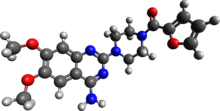 | |
 | |
| Clinical data | |
|---|---|
| Trade names | Minipress, others |
| AHFS/Drugs.com | Monograph |
| MedlinePlus | a682245 |
| License data | |
| Pregnancy category |
|
| Routes of administration | By mouth |
| Drug class | α1 blocker |
| ATC code | |
| Legal status | |
| Legal status | |
| Pharmacokinetic data | |
| Bioavailability | ~60% |
| Protein binding | 97%[4] |
| Onset of action | 30–90 minutes[5] |
| Elimination half-life | 2–3 hours[4] |
| Duration of action | 10–24 hours[4] |
| Identifiers | |
| |
| CAS Number | |
| PubChem CID | |
| IUPHAR/BPS | |
| DrugBank | |
| ChemSpider | |
| UNII | |
| KEGG | |
| ChEBI | |
| ChEMBL | |
| CompTox Dashboard (EPA) | |
| ECHA InfoCard | 100.038.971 |
| Chemical and physical data | |
| Formula | C19H21N5O4 |
| Molar mass | 383.408 g·mol−1 |
| 3D model (JSmol) | |
| |
| |
| (verify) | |
Prazosin, sold under the brand name Minipress among others, is a medication used to treat high blood pressure, symptoms of an enlarged prostate, and nightmares related to post-traumatic stress disorder (PTSD).[6] It is an α1 blocker.[6] It is a less preferred treatment of high blood pressure.[6] Other uses may include heart failure and Raynaud syndrome.[7] It is taken by mouth.[6]
Common side effects include dizziness, sleepiness, nausea, and heart palpitations.[6] Serious side effects may include low blood pressure with standing and depression.[6][7] Prazosin is a non-selective inverse agonist of the α1-adrenergic receptors.[6] It works to decrease blood pressure by dilating blood vessels and helps with an enlarged prostate by relaxing the outflow of the bladder.[6] How it works in PTSD is not entirely clear.[6]
Prazosin was patented in 1965 and came into medical use in 1974.[8] It is available as a generic medication.[6] In 2021, it was the 183rd most commonly prescribed medication in the United States, with more than 2 million prescriptions.[9][10]
- ^ "Prazosin (Minipress) Use During Pregnancy". Drugs.com. 26 November 2019. Retrieved 30 January 2020.
- ^ "Hypovase Tablets 0.5mg - Summary of Product Characteristics (SmPC)". (emc). 26 April 2021. Retrieved 5 February 2023.
- ^ "Minipress- prazosin hydrochloride capsule". DailyMed. 19 July 2021. Retrieved 5 February 2023.
- ^ a b c "Prazosin". drugs.com. Retrieved 15 March 2020.
- ^ Packer M, Meller J, Gorlin R, Herman MV (March 1979). "Hemodynamic and clinical tachyphylaxis to prazosin-mediated afterload reduction in severe chronic congestive heart failure". Circulation. 59 (3): 531–539. doi:10.1161/01.cir.59.3.531. PMID 761333.
- ^ a b c d e f g h i j "Prazosin Hydrochloride Monograph for Professionals". Drugs.com. American Society of Health-System Pharmacists. Retrieved 18 March 2019.
- ^ a b British national formulary : BNF 76 (76 ed.). Pharmaceutical Press. 2018. p. 766. ISBN 9780857113382.
- ^ Fischer J, Ganellin CR (2006). Analogue-based Drug Discovery. John Wiley & Sons. p. 455. ISBN 9783527607495.
- ^ "The Top 300 of 2021". ClinCalc. Archived from the original on 15 January 2024. Retrieved 14 January 2024.
- ^ "Prazosin - Drug Usage Statistics". ClinCalc. Retrieved 14 January 2024.